|
Memorial to the
Mossfield Colliery disaster
The Cockshead coal
seam (which was mined at Mossfield) was subject to gob fires (an
area that has been left void after the coal has been extracted and
fires are caused by spontaneous combustion).
A series of explosions began on the 12th September , probably due to
the access of air to the gob fire and the crushing of the extremely
thin pillars of coal separating the two workings. On October 16th
1889 there was a massive explosion, resulting in the death of 64
miners at Mossfield Colliery.
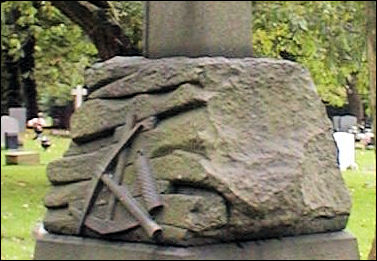
Close-up of the base of the Longton
Cemetery memorial
THE TERRIBLE
COLLIERY DISASTER NEAR LONGTON.
"On Sunday the bodies
of 29 of the colliers whose lives were sacrificed in the fearful
explosion at the Moss-field Colliery, Adderley Green, were interred
in Longton Cemetery amid many manifestations of respect.
It was a long and
weary day of sorrow. On every hand signs of mourning were visible;
flags were hoisted at half-mast on the churches, Town Hall, and
other buildings, and blinds were generally drawn throughout the
borough, while -all along the enormous crowds that thronged the
approaches to the cemetery and adjacent thoroughfares there was
perfect order and decorum. Everyone seemed to feel they were sharing
a personal sorrow.
The sad ceremony of
burial commenced at noon, and for five hours till dusk groups of
sorrowful mourners gathered around the graves of those they had
loved, while-procession succeeded procession at brief intervals. The
spot selected -for the repose of the victims of the disaster lies on
the south-western side of the cemetery, and there side by side in
separate graves the bodies of the departed were reverently laid.
Thirty graves were opened on Sunday, but if necessary there is space
sufficient for 20 more. The day for the most part was in keeping
with the mourning all around.
The arrangements at
the cemetery were complete in every respect. The public were not
admitted, which added considerably to the perfect order preserved.
As the funerals arrived, the bodies were taken into the church or
chapel as the case might be, and as an instance of Christian union
it may be mentioned that clergymen conducted several funerals in the
chapel, while the Dissenting ministers were invited to use the
church. The bodies were borne to the grave, followed by weeping
mourners, where the service, which was slightly shortened, was
concluded.
...... The funeral of
Jacob Bath, of 26, Barker-street, was attended by the members of the
Fenton Lodge of United Shepherds, of which the deceased was a
member. No hearse was used, but six of the Shepherds carried the
coffin from the deceased's late residence to the grave-side. The
lodge lost three members by the disaster.
Another special
funeral was that of John Bough, who was interred according to the
sacred ritual of the Roman Catholic Church. The body-was first taken
into the porch of the St. Gregory schools, which are opposite the
cemetery, and where the first portion of the service was conducted
in Latin. The solemn procession, headed by the two priests, ... then
proceeded to the grave, where the service was concluded in English.
The aged Derricott and his son-in-law, Thomas Brough, were interred
in the same grave, as were the brothers Smith and James.
.... At nearly all the
churches and chapels in the Pottery district special reference was
made to the sad calamity. Thousands of persons from all parts of the
country visited the scene of the explosion all through Sunday, while
crowds thronged the neighbourhood of Adderley Green, Sandford Hill,
and Ashwood."
The Staffordshire
Advertiser, October 1889
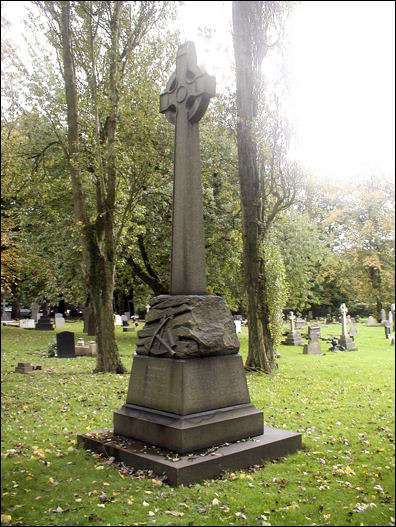
the Longton
Cemetery memorial
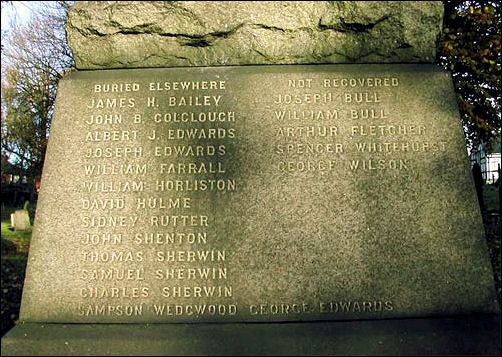
the names of those
buried in other burial grounds
and those not recovered
the inquiry stated:
"Five bodies still remain in the seam as it was considered
imprudent to reopen that portion of the mine in which they probably
lie."
|
Arthur
Fletcher was one of those whose bodies were never recovered.
"Signs of
gob fire number 5 were first noted by the men working in
number 5 drift on 14th October 1889, two days before the
explosion. There was the characteristic smell and the men
complained and Arthur Fletcher, the nightshift fireman,
reported this to his father William, the Under Manager, the
next morning.
William
Fletcher informed Mr. Potts, the Manager, that a gob fire was
breaking out in number 5 drift. The plans of the workings were
laid out on the colliery desk and Mr. Potts said that the next
day he would put stoppings in place at points nearest to the
gob fire where it would be possible to erect air tight
stoppings. But the Manager did not go down the pit despite the
fact that the Coal Mines Act 1886 states quite clearly in Rule
24 that a Manager must go down into the pit and see for
himself and not rely on hearsay. Arthur Fletcher the
nightshift deputy, aged 26, was more vehement than his father
and he maintained that all the men should be withdrawn from
the pit immediately.
He
said, "We are sitting on a time bomb with a dangerously short
fuse", and over his father's head he demanded an interview
with Mr. Potts. The manager replied that because of a previous
engagement he would not be home until midnight. "Then I'll be
waiting for you when you come home at midnight" replied Arthur
Potts, realising that he was up against a determined young man
and despite the fact that he had this engagement, he went to
the pit top at 9.00 p.m. but as Arthur was in charge of both
the Bambury and Cockshead workings he had to be in the pit
before the nightshift came on at 9.30 p.m. to examine the
districts to see that they were fit for the men to go to work
in, so they agreed to meet at midnight.
After making his rounds underground Fletcher advised the men
to keep clear of the danger spot until he returned from his
meeting with the manager whose residence was only a few
minutes walk from the pit top.
Now whatever passed between these two officials we shall never
know. We have only Mr. Potts' version, which incidentally the
inquiry found contradictory and unsatisfactory.
Arthur Fletcher's account died with him a few hours later.
Though it was common knowledge that he wanted all the men
withdrawn from the pit." |
www.healeyhero.co.uk
Memorial at
the Mossfield Colliery site
Location: Berryhill fields - top of pathway
at entrance to park nearest to Hall Hill Drive
Installed: 2000
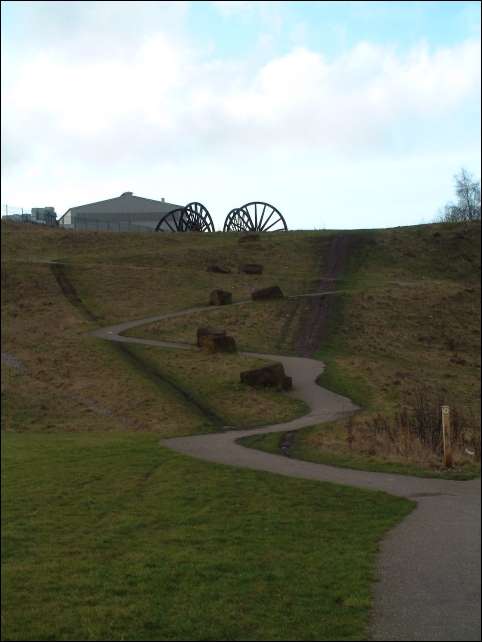
Four pithead
winding wheels, half set into the ground. Pointing in four different
direction. The wheels are painted black and have nameplates which
depict the local seams mined and some of the collieries in the area.
The wheels are set on the levelled off spoil heap of Mossfield
Colliery.
Inscription:
(concrete circle - surrounded by
cobblestones)
"THERE'S BLACK ASH BENEATH
THE GREEN
GOB FIRES BURNING UNDER GAS HILL
AND BENEATH IT ALL
BONES OF MINERS BURIED
STILL"
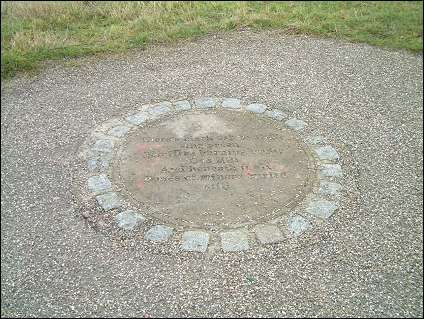
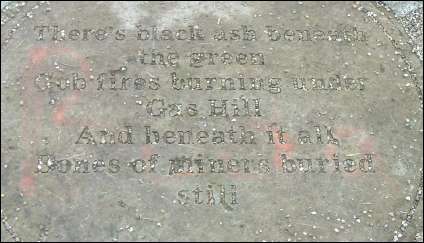

|
![]()
![]()
![]()